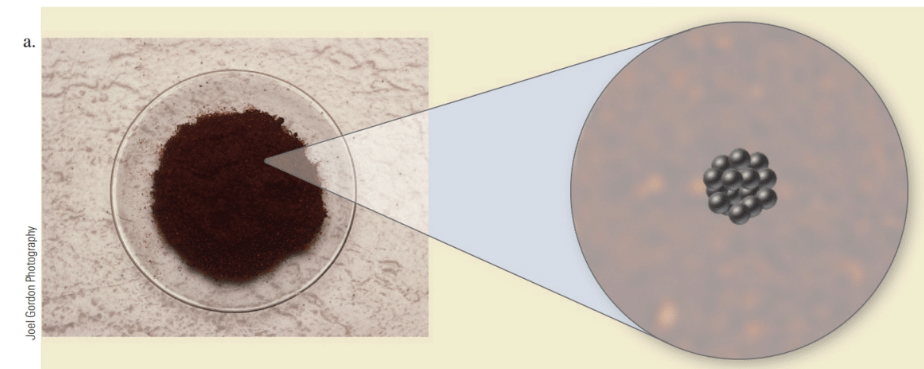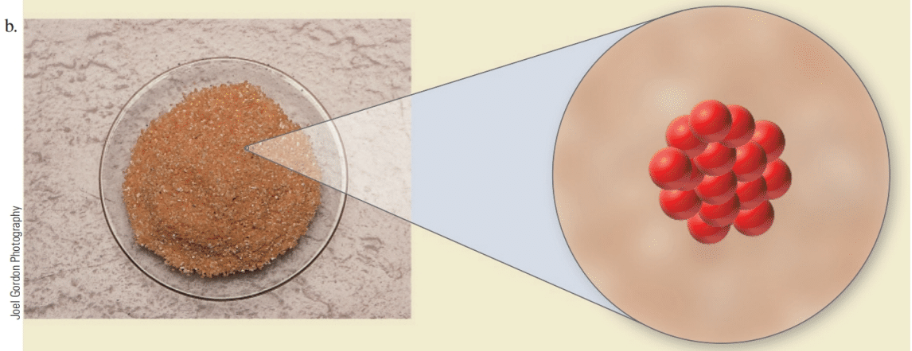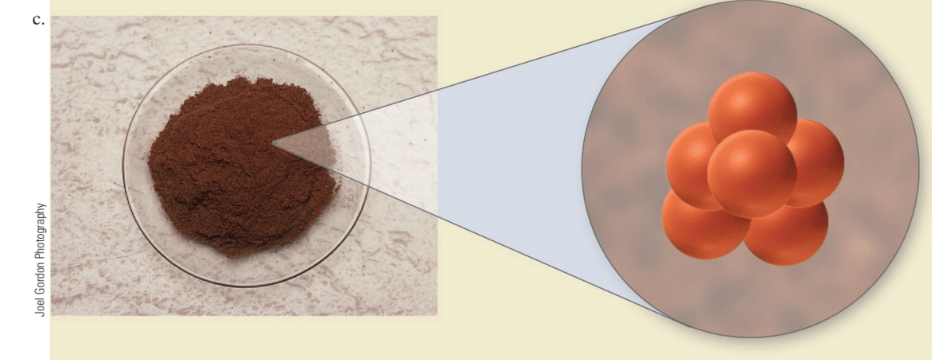
Bundle: Chemistry In Focus: A Molecular View Of Our World, 7th + Owlv2 With Mindtap Reader, 1 Term (6 Months) Printed Access Card
7th Edition
ISBN: 9781337812221
Author: Nivaldo J. Tro
Publisher: Cengage Learning
expand_more
expand_more
format_list_bulleted
Concept explainers
Textbook Question
Chapter 3, Problem 65E
Here are three fictitious elements and a molecular view of the atoms that compose them. The molar mass of the middle element, (b), is 25 grams per dozen (g/doz). (The atoms of these fictitious elements are much larger than ordinary atoms.)



Based on the size of the atoms, do you expect the
Expert Solution & Answer
Trending nowThis is a popular solution!

Students have asked these similar questions
in the scope of the SCH4U course! please show all steps as im still learning how to format my answers in the format given, thank you!
help me solve this HW
Molecules of the form AH2 can exist in two potential geometries: linear or bent. Construct molecular orbital diagrams for linear and bent CH2. Identify the relevant point group, include all of the appropriate symmetry labels and pictures, and fill in the electrons. Which geometry would you predict to be more stable, and why? (Please draw out the diagram and explain)
Chapter 3 Solutions
Bundle: Chemistry In Focus: A Molecular View Of Our World, 7th + Owlv2 With Mindtap Reader, 1 Term (6 Months) Printed Access Card
Ch. 3 - Determining the Number of Protons and Electrons in...Ch. 3 - Prob. 3.2YTCh. 3 - Determining Protons, Neutrons, and Electrons How...Ch. 3 - Calculating Atomic Mass Magnesium has three...Ch. 3 - The Mole Concept A diamond, which is pure carbon,...Ch. 3 - The Mole Concept II Calculate the number of atoms...Ch. 3 - Your friend tells you about an article that he...Ch. 3 - Prob. 2SCCh. 3 - Prob. 3SCCh. 3 - Copper is composed of two naturally occurring...
Ch. 3 - Prob. 5SCCh. 3 - Which pair of elements do you expect to be most...Ch. 3 - Which statement is true of the quantum mechanical...Ch. 3 - Why is it important to understand atoms?Ch. 3 - Prob. 2ECh. 3 - What defines an element? How many naturally...Ch. 3 - Prob. 4ECh. 3 - Prob. 5ECh. 3 - Prob. 6ECh. 3 - Prob. 7ECh. 3 - Prob. 8ECh. 3 - Prob. 9ECh. 3 - Prob. 10ECh. 3 - Explain the quantum mechanical model for the atom....Ch. 3 - Give two examples of each: a. alkali metal b....Ch. 3 - Which elements exist as diatomic molecules?Ch. 3 - Explain the difference and similarity between...Ch. 3 - Prob. 15ECh. 3 - Determine the charge of each of the following: a...Ch. 3 - Determine the number of protons and electrons in...Ch. 3 - Determine the number of protons and electrons in...Ch. 3 - Give the atomic number (Z) and the mass number (A)...Ch. 3 - Prob. 20ECh. 3 - The following isotopes have applications in...Ch. 3 - The following isotopes are important in nuclear...Ch. 3 - 14C is used in carbon dating of artifacts....Ch. 3 - 40K is used to measure the age of Earth. Determine...Ch. 3 - Prob. 25ECh. 3 - Prob. 26ECh. 3 - Give electron configurations according to the Bohr...Ch. 3 - Give electron configurations according to the Bohr...Ch. 3 - Prob. 29ECh. 3 - How many valence electrons are in each element of...Ch. 3 - Prob. 31ECh. 3 - Draw electron configurations for each of the...Ch. 3 - Which two of the following elements would you...Ch. 3 - Group the following elements into three similar...Ch. 3 - We have seen that the reactivity of an element is...Ch. 3 - What is the electron configuration of Mg2+? How...Ch. 3 - Classify each of the following elements as a...Ch. 3 - Classify each of the following as a metal, a...Ch. 3 - Calculate the atomic mass of neon (Ne), which is...Ch. 3 - An element has two naturally occurring isotopes....Ch. 3 - A fictitious element has two naturally occurring...Ch. 3 - Copper has two naturally occurring isotopes. Cu-63...Ch. 3 - How many moles of titanium are present in 124 g of...Ch. 3 - Prob. 44ECh. 3 - How many moles are there in each sample? a. 45 mg...Ch. 3 - How many moles are there in each sample? a. 55.0 g...Ch. 3 - What is the mass of each sample? a.1.8 mol S...Ch. 3 - What is the mass of each sample? a.2.75 mol Fe...Ch. 3 - Determine the number of atoms in each sample....Ch. 3 - Determine the number of atoms in each sample....Ch. 3 - How many Ag atoms are present in a piece of pure...Ch. 3 - How many platinum atoms are in a pure platinum...Ch. 3 - A pure gold necklace has a volume of 1.8cm3. How...Ch. 3 - A titanium bicycle component has a volume of...Ch. 3 - An iron sphere has a radius of 3.4 cm. How many...Ch. 3 - Calculate the number of atoms in the universe. The...Ch. 3 - The introduction to this chapter states that...Ch. 3 - Suppose the absolute value of the charge of the...Ch. 3 - When we refer to doughnuts or cookies, we often...Ch. 3 - Prob. 60ECh. 3 - Why does Avogadros number have such an odd value?...Ch. 3 - Prob. 62ECh. 3 - Prob. 63ECh. 3 - Prob. 64ECh. 3 - Here are three fictitious elements and a molecular...Ch. 3 - Prob. 66ECh. 3 - Gather any two of the following items, measure...
Knowledge Booster
Learn more about
Need a deep-dive on the concept behind this application? Look no further. Learn more about this topic, chemistry and related others by exploring similar questions and additional content below.Similar questions
- Indicate the variation in conductivity with concentration in solutions of strong electrolytes and weak electrolytes.arrow_forwardThe molar conductivity of a very dilute solution of NaCl has been determined. If it is diluted to one-fourth of the initial concentration, qualitatively explain how the molar conductivity of the new solution will compare with the first.arrow_forwardWhat does the phrase mean, if instead of 1 Faraday of electricity, Q coulombs (Q/F Faradays) pass through?arrow_forward
- What characteristics should an interface that forms an electrode have?arrow_forwardFor a weak acid AcH, calculate the dissociated fraction (alpha), if its concentration is 1.540 mol L-1 and the concentration [H+] is 5.01x10-4 mol L-1.arrow_forwardIf the molar conductivity at infinite dilution of HAC is A0 = 390.5 S cm² mol¹. Calculate the Arrhenius conductivity of a 9.3% by weight solution of HAc with a pH of 3.3. Data: molecular weight of HAC is 60.05 g/mol and the density of the solution is 1 g/cm³.arrow_forward
- If the molar conductivity at infinite dilution of HAC is A0 = 390.5 S cm² mol¹. Calculate the Arrhenius conductivity of a 9.3% by weight solution of HAc with a pH of 3.3. Data: molecular weight of HAC is 60.05 g/mol and the density of the solution is 1 g/cm³.arrow_forwardIf the molar conductivity at infinite dilution of HAC is A0 = 390.5 S cm² mol¹. Calculate the Arrhenius conductivity of a 9.3% by weight solution of HAc with a pH of 3.3. Data: molecular weight of HAC is 60.05 g/mol and the density of the solution is 1 g/cm³.arrow_forwardDetermine the distance between the metal and the OHP layer using the Helm- holtz model when the electrode's differential capacitance is 145 μF cm². DATA: dielectric constant of the medium for the interfacial zone &r= lectric constant of the vacuum &0 = 8.85-10-12 F m-1 = 50, die-arrow_forward
- Describe a sequence of photophysical processes that can be followed by radiation adsorbed by a molecule in the ground state to give rise to phosphorescent emission.arrow_forwardState two similarities between fluorescence and phosphorescence.arrow_forwardState three photophysical processes that can be related to the effects of incident radiation on a molecule in its ground state. Consider that radiation can give rise to fluorescent emission, but not phosphorescent emission.arrow_forward
arrow_back_ios
SEE MORE QUESTIONS
arrow_forward_ios
Recommended textbooks for you
 Chemistry for Engineering StudentsChemistryISBN:9781337398909Author:Lawrence S. Brown, Tom HolmePublisher:Cengage Learning
Chemistry for Engineering StudentsChemistryISBN:9781337398909Author:Lawrence S. Brown, Tom HolmePublisher:Cengage Learning Chemistry: The Molecular ScienceChemistryISBN:9781285199047Author:John W. Moore, Conrad L. StanitskiPublisher:Cengage LearningChemistry: Matter and ChangeChemistryISBN:9780078746376Author:Dinah Zike, Laurel Dingrando, Nicholas Hainen, Cheryl WistromPublisher:Glencoe/McGraw-Hill School Pub Co
Chemistry: The Molecular ScienceChemistryISBN:9781285199047Author:John W. Moore, Conrad L. StanitskiPublisher:Cengage LearningChemistry: Matter and ChangeChemistryISBN:9780078746376Author:Dinah Zike, Laurel Dingrando, Nicholas Hainen, Cheryl WistromPublisher:Glencoe/McGraw-Hill School Pub Co
 Chemistry: Principles and ReactionsChemistryISBN:9781305079373Author:William L. Masterton, Cecile N. HurleyPublisher:Cengage Learning
Chemistry: Principles and ReactionsChemistryISBN:9781305079373Author:William L. Masterton, Cecile N. HurleyPublisher:Cengage Learning Introduction to General, Organic and BiochemistryChemistryISBN:9781285869759Author:Frederick A. Bettelheim, William H. Brown, Mary K. Campbell, Shawn O. Farrell, Omar TorresPublisher:Cengage Learning
Introduction to General, Organic and BiochemistryChemistryISBN:9781285869759Author:Frederick A. Bettelheim, William H. Brown, Mary K. Campbell, Shawn O. Farrell, Omar TorresPublisher:Cengage Learning

Chemistry for Engineering Students
Chemistry
ISBN:9781337398909
Author:Lawrence S. Brown, Tom Holme
Publisher:Cengage Learning

Chemistry: The Molecular Science
Chemistry
ISBN:9781285199047
Author:John W. Moore, Conrad L. Stanitski
Publisher:Cengage Learning

Chemistry: Matter and Change
Chemistry
ISBN:9780078746376
Author:Dinah Zike, Laurel Dingrando, Nicholas Hainen, Cheryl Wistrom
Publisher:Glencoe/McGraw-Hill School Pub Co


Chemistry: Principles and Reactions
Chemistry
ISBN:9781305079373
Author:William L. Masterton, Cecile N. Hurley
Publisher:Cengage Learning

Introduction to General, Organic and Biochemistry
Chemistry
ISBN:9781285869759
Author:Frederick A. Bettelheim, William H. Brown, Mary K. Campbell, Shawn O. Farrell, Omar Torres
Publisher:Cengage Learning
NEET Chemistry | Group 14 Carbon Family | Theory & Problem Solving | In English | Misostudy; Author: Misostudy;https://www.youtube.com/watch?v=enOGIrcHh54;License: Standard YouTube License, CC-BY